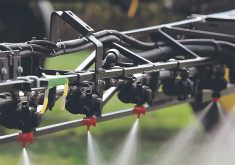The weather outside may be frightful, but inside the greenhouses of Wenkai Oriental Vegetables in Elie, Man., even on a January afternoon with a brisk wind tearing across the prairie, it’s a balmy 27 C.
With the bright sun coming through the single layer of six-millimetre-thick plastic that covers the structure’s southern exposure and tiny transplanted Chinese cabbage seedlings poking up in neat rows in the damp, rich black soil, it feels more like a beautiful morning in June.
Unlike most greenhouses, which are heavily dependent on expensive supplementary heat, mainly natural gas, Wenkai Liu’s operation runs on pennies a day.
Read Also

University of Manitoba hires potato researcher
A new research chair position at the University of Manitoba will tackle sustainability in the potato industry.
“Even when it’s -30 C, we don’t have to use any heat to keep it warm,” said Liu. “Our design offers energy savings of about 95 percent.”
The three 100 foot by 23 foot greenhouses, which were built using a design that is common in China, store heat from the sun in a 15 centimetre thick, two metre high stud frame wall filled with dry sand, and covered on the inside with aluminum sheeting that has been painted black. The outside has a layer of fiberglass insulation covered with plywood.
On top of the wall, at a 45 degree angle toward the peak, oriented strand board has been attached to the welded steel rafters, which are spaced about 60 cm apart, to reflect sunlight and heat up the dirt floor where the plants grow. The greenhouse walls rest on a foundation that consists of 11/2 metre concrete pilings that were poured in place every four metres.
At night, Liu pushes a button and electric motors lower a retractable blanket over the plastic, trapping the sun’s heat inside the greenhouse.
The blanket consists of two weatherproof cotton tarps stuffed with insulation and stitched together like a sandwich, which offers an R-value of 17.
The 2 x 6 studs that make up the east and west ends of the structure are stuffed with fiberglass pink insulation, and a small shed at the entrance serves double duty as a storage space for tools and an airlock entry that keeps the cold out.
For really cold nights, a small forced-air electric heater with a thermostat set at 5 C kicks in to prevent freezing, and a small woodstove serves the same purpose in a second greenhouse. The combination of collecting free heat from the sun in the sand-filled wall during the day and slowly releasing it at night means that Liu’s electricity bill for heating all three greenhouses in winter averages just $140 a month.
In summer, when the temperature inside gets too hot, the plastic can be raised by turning a crank connected to bicycle sprockets and chain.
Liu, who has lived near Elie with his wife and two young children since 1996, built the greenhouses two years ago with the help of a $20,000 research grant from Manitoba’s agriculture ministry, and technical assistance from Shenyang University in northeastern China.
“I brought the technology from China to show people how to operate a greenhouse in winter and save energy,” said Liu, 50, who was born in China.
Before that, he got a master’s degree in agriculture from North Dakota State University and worked in Venezuela for two years as an expert adviser. He also grows Chinese vegetables outdoors on his 10 acre farm during the summer, which he sells at fresh markets and through a contract agreement with Superstore.
Shenyang, China has a similar climate to Elie, which is about 100 kilometres north of the U.S. border. Winter temperatures in China’s northern interior commonly dip as low as -35 C, he said.
Depending on which vegetables are planted, he can harvest three to four crops a year. If he plants Chinese cabbage, total annual yield is about 8,000 kilograms. Tomatoes yield about 1,000-2,000 kg per season because only two crops can be grown in a year. Chinese cabbage grows faster and is ready to be picked in 40-50 days in winter and 35 days in summer. The shorter days in winter make plants grow more slowly, he said.
Soil fertility is maintained with a mix of composted cattle and chicken manure, with a dash of liquid commercial fertilizer to give the plants an early boost. Insect pests are not a problem in the greenhouse, Liu said, although he has had trouble with two-legged garden thieves in his outside plots.
“Once a guy was stealing my vegetables. I went over to tell him to stop and he drove off so fast that his truck rolled over in the ditch.
Liu sells the welded steel trusses and the covering blanket, which are made in China, for $10,000 per greenhouse.














